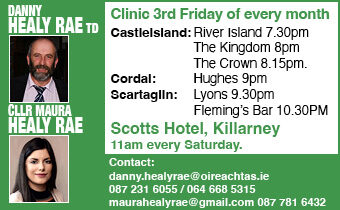
Castleisland Desmonds GAA Club has gone the polite route in approaching local dog owners to take responsibility for the pooing habits of their beloved pets.
Signs have been erected at the entrances and within the grounds at Moanmore as the area attracts many pet owners from the locality. Quite a lot of passing traffic take advantage of the ‘ideal’ location also to give their pets a run out – and all that entails.
It must be the best part of 30 years ago that a man came on the Late Late Show to talk about the dangers of children coming into contact with dog faeces.
He told host Gay Byrne, and a horrified and pet-loving nation, that dog faeces caused untold, internal damage and possible blindness to the human system where it comes into contact with it.
Legal cases have been taken against sporting clubs by the parents of young children who have been ‘invaded’ by the bacteria associated with dog faeces.
This faeces can pose a significant health risk to humans, particularly young children as their immune systems are not fully developed. Children are also more likely to come into contact with soil or sand that contains dog faeces whilst playing in parks, gardens and playgrounds. All faeces contain bacteria that can cause stomach upsets, but the greatest risk is from toxocariasis.
Toxocariasis is particularly hazardous to small children as it can result in blindness. Most of us will not, thankfully, have heard of or encountered Toxocariasis, but we need to know exactly what it is and how to prevent it. Even if you don’t have a pet yourself it’s no harm to make yourself aware of the risks.
Toxocara is the name given to a species of roundworm commonly found in dogs and cats. Virtually all puppies are born with Toxocara. Puppies and kittens can also be infected with Toxocara through their mother’s milk or from environmental contamination. The type of toxocara found in dogs can endanger human health. The type of toxocara found in cats has only rarely been associated with cases of Toxocariasis (Toxocara infection).
Microscopic toxocara eggs are present in the faeces of infected animals. These eggs have thick, sticky shells which means that they can remain infective in the soil for two to four years after the faeces have disappeared. The sticky shell helps eggs to adhere to fingers or clothing.
By accidentally swallowing the infective Toxocara eggs. This is why crawling babies and toddlers are most at risk; they tend to put dirty fingers and toys into their mouths. Medical records show that approximately 100 new cases of Toxocariasis are diagnosed each year.
Once swallowed, Toxocara eggs release larvae into the intestine. These larvae travel through the body until they die, which may take several years. The symptoms of this disease can be unpleasant and difficult to treat. They can include stomach upset and pain, headache, sore throat, wheezing and listlessness. In some cases, larvae reach the eyes where they can cause sight problems and in some cases blindness.
A 10 step guide to preventing Toxocara
1. NEVER take a dog or cat to a play or sports area.
2. Always clear up pet faeces immediately using a nappy sack, a carrier bag or a poop scoop bag, and deposit it in the nearest dog bin or, if at home, in a safe and secure bin.
3. Make sure that children always wash their hands, especially after playing outside and before eating.
4. Discourage your child from sucking its fingers. This is one of the most common ways for children to get infected.
5. Don’t allow children to play on the ground and eat using their fingers at the same time.
6. Be sure that floors where children play at home are cleaned with antibacterial cleaners. This practice kills Toxocara eggs that may have been transported into your home on your shoes or on your pet’s paws.
7. Don’t put small children on the entrance floors of public buildings.
8. Don’t leave young children unsupervised with a pet.
9. Fence around play areas to keep your children safe and also to keep dogs away from play equipment.
10. Cover sandpits to keep cats and dogs out.










































